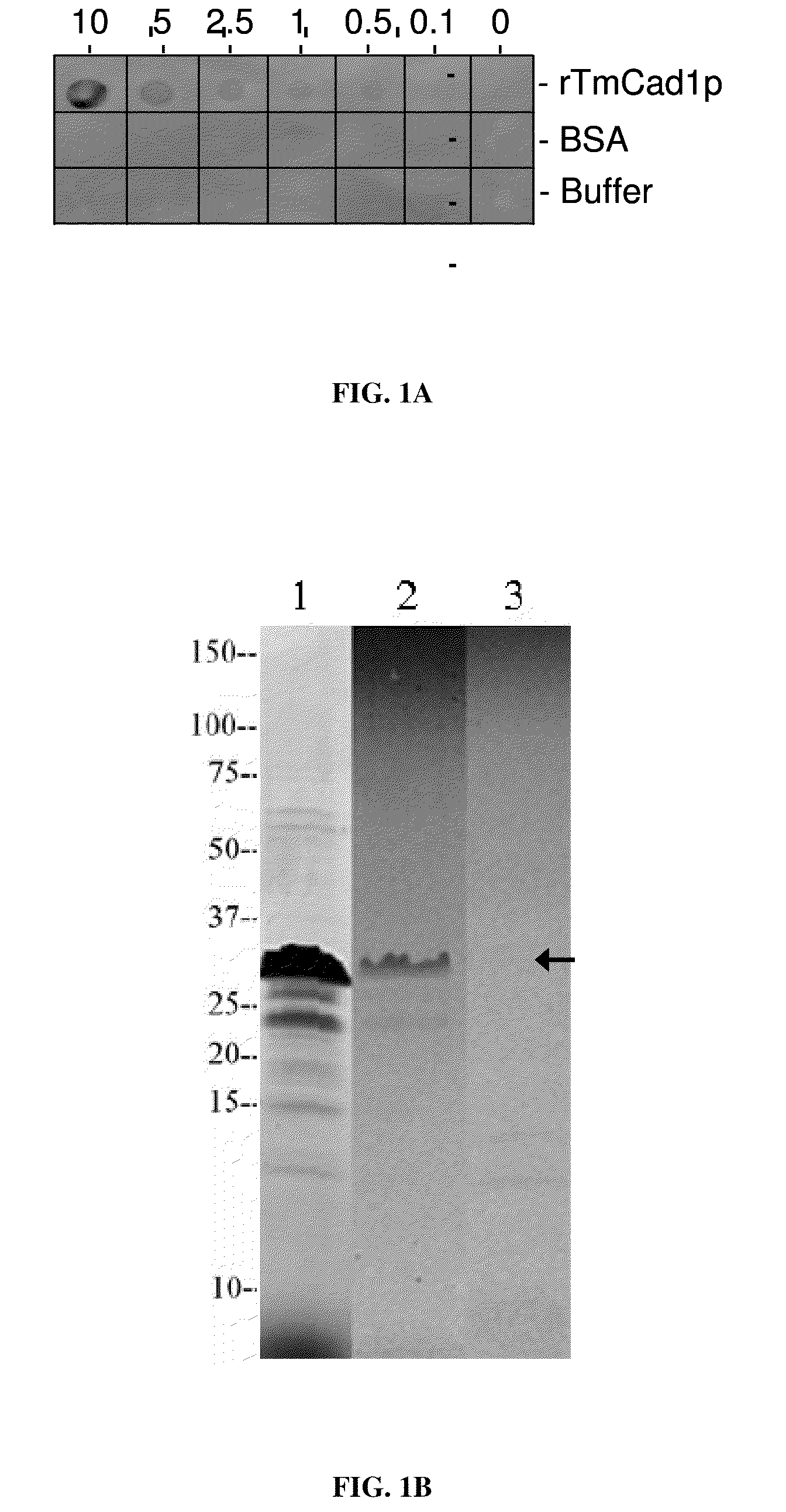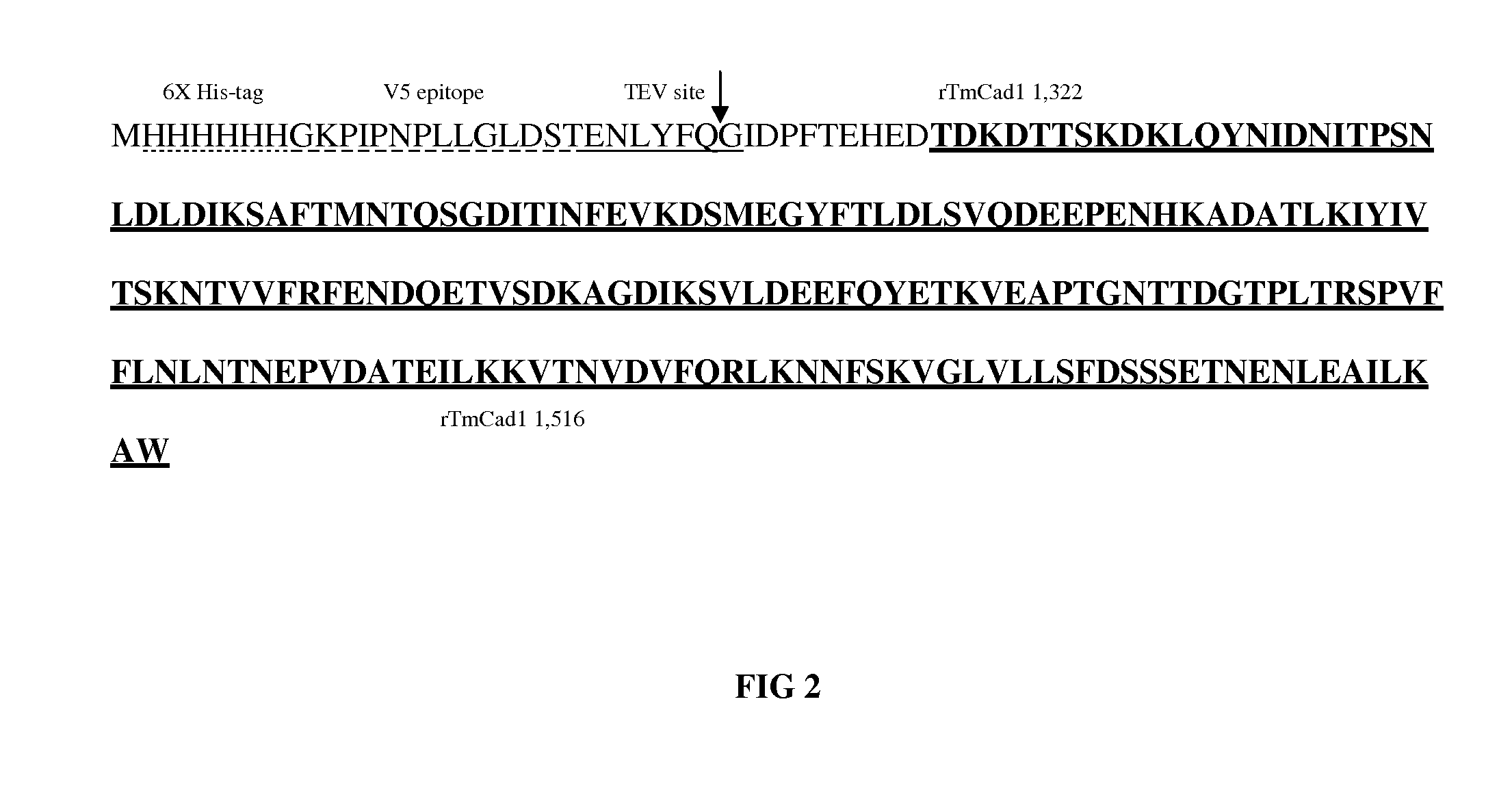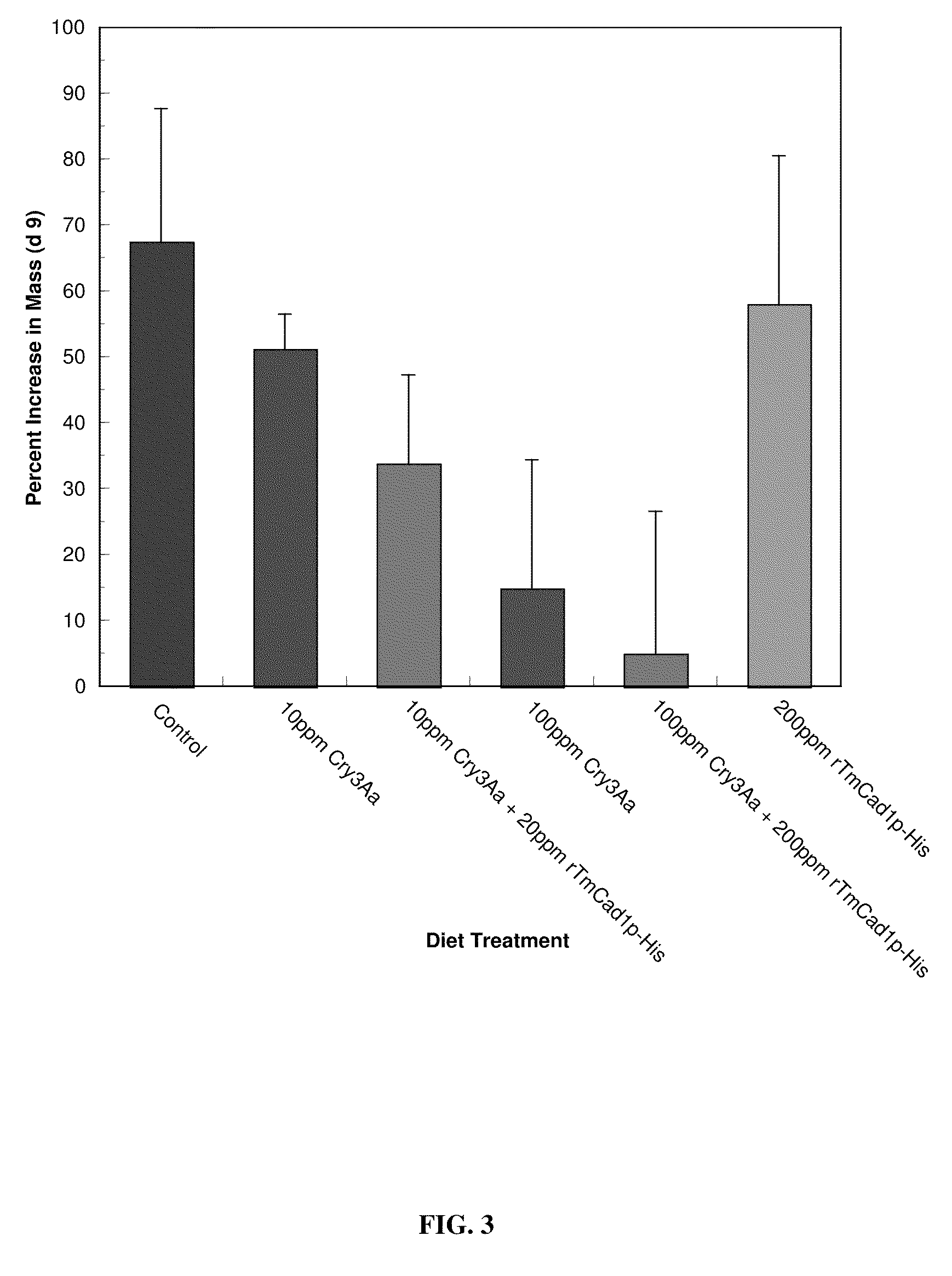NOVEL CADHERIN RECEPTOR PEPTIDE FOR POTENTIATING Bt BIOPESTICIDES
a cadherin receptor and peptide technology, applied in the field of new cadherin fragment peptides, can solve the problems of 1 billion dollars in damage to corn crops, and extensive damage to crops
- Summary
- Abstract
- Description
- Claims
- Application Information
AI Technical Summary
Benefits of technology
Problems solved by technology
Method used
Image
Examples
example 1
[0071]In dot blot assays, 0.1, 0.5, 1, 2.5, 5, and 10 μg of rTmCad1p obtained from E. coli BL21 was spotted and dried on Immobilon-P PVDF membrane (Millipore, Billerica, Mass.). The membrane was blocked with 3% bovine serum albumin in PBS (0.08 M Na2HPO4, 0.02 M NaH2PO4, 0.1 M NaCl, pH 7.4) for at least one hour. Incubations with target ligands were done for 2 h in PBS, pH 7.4, 0.1% BSA, 0.1% Tween-20. Blots were washed between each step three times for 5 min in wash buffer (PBS buffer, pH 7.4, 0.2% BSA, 0.1% Tween-20). Blots were incubated with 100 nM Cry3Aa (spore / crystalline toxin preparation from Bacillus thuringiensis var. tenebrionis) in PBS buffer, pH 7.4, 0.1% BSA, 0.3% Tween-20 followed by 1:5000-diluted rabbit anti-Cry3Aa sera (in wash buffer) and 1:5000-diluted ECL peroxidase-labeled anti-rabbit sera (in wash buffer). ECL Western blotting detection reagent (Amersham RPN2209) was used to visualize peroxidase activity on a Fluor Chem imager (Innotech). All steps were carrie...
example 2
[0072]Toxin binding in-gel assays were according to the manufacturer recommendation (LI-COR Biosciences, Lincoln, Nebr.). Briefly, rTmCad1p obtained from E. coli BL21, was separated by SDS-PAGE on a 10-20% Tricine gel with Tricine sample and running buffers (Invitrogen, Carlsbad, Calif.). After electrophoresis, gels were fixed in 45% methanol / 10% acetic acid for 15 min. Separate gels were either stained with Coomassie blue (Imperial Protein Stain, Pierce Chemical Co., Rockford, Ill.), or were incubated with 2.35 μg IR-labeled toxin in 10 mL 1% BSA in 1× wash buffer (0.002 M imidazole-buffered saline with 0.02% Tween 20, KPL, Gaithersburg, Md.), with or without 100-fold excess rTmCad1p, overnight at room temperature with gentle shaking. Gels were washed thrice in wash buffer and scanned at 800 nm on an Odyssey Imager using v. 1.2.15 Odyssey software (LI-COR).
[0073]Chymotrypsin-activated Cry3Aa was labeled with a fluorescent dye using the IRDye 800CW Protein Labeling Kit (LI-COR Biosc...
example 3
[0075]rTmCad1p obtained from E. coli BL21, was premixed with Cry3Aa and added to the diet (10 mg total comprising of 50% glucose / 30% yeast / 20% wheat germ) with a T. molitor larva, as indicated in FIG. 3. rTmCad1p was mixed with 10 ppm (0.154 μM) or 100 ppm (1.54 μM) Cry3Aa to maintain a molar ratio of 1:5 toxin:rTmCad1p. T. molitor larvae aged approximately 1 month and weighed 1.4-4.3 mg when placed on diets. Larvae were weighed at regular intervals, and the percent change in the mass±S.D were determined. Although the difference between treatments and control were not statistically significant (one-way ANOVAs with Holm-Sidak comparisons) because of the large variation in larval weights, larvae fed rTmCad1p were smaller than those without peptide or control.
[0076]Bioassay results of T. molitor using whole grain bread discs cut using a 2 mm cork borer and placed into a microtiter plate well are shown in FIG. 4. Doses of Cry3Aa toxin, rTmCad1p peptide, or toxin and peptide at Cry3Aa:rT...
PUM
| Property | Measurement | Unit |
|---|---|---|
| molar ratio | aaaaa | aaaaa |
| molecular mass | aaaaa | aaaaa |
| pH | aaaaa | aaaaa |
Abstract
Description
Claims
Application Information
 Login to View More
Login to View More - R&D
- Intellectual Property
- Life Sciences
- Materials
- Tech Scout
- Unparalleled Data Quality
- Higher Quality Content
- 60% Fewer Hallucinations
Browse by: Latest US Patents, China's latest patents, Technical Efficacy Thesaurus, Application Domain, Technology Topic, Popular Technical Reports.
© 2025 PatSnap. All rights reserved.Legal|Privacy policy|Modern Slavery Act Transparency Statement|Sitemap|About US| Contact US: help@patsnap.com



